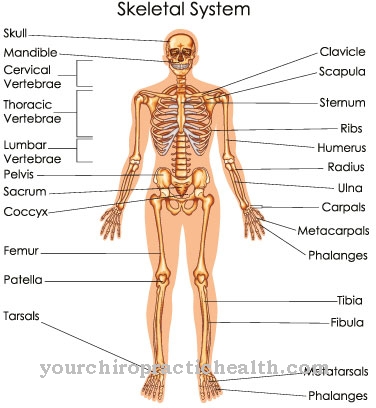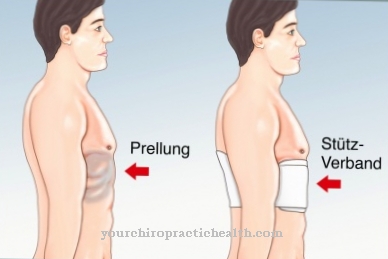The Smith-Lemli-Opitz syndrome is a cogenital malformation syndrome. The cause is one of a total of 70 gene mutations on chromosome 11q13.4. The disease is inherited in an autosomal recessive manner and is an extremely rare disease with multiple organ malformations and impaired cholesterol biosynthesis.
What is Smith-Lemli-Opitz Syndrome?

© jijomathai - stock.adobe.com
The Smith-Lemli-Opitz syndrome falls into the group of autosomal recessive hereditary malformation syndromes. A gene mutation causes a metabolic disorder in the biosynthesis of cholesterol in the disease. The syndrome is the most common cogenital disorder of cholesterol biosynthesis. The prevalence of the disease in Europe is between about 1: 60,000 and 1: 10,000.
The disease can thus be classified as a rare disease, although it is one of the most common cogenital diseases in cholesterol biosynthesis. The syndrome is even rarer on the continents of Asia and Africa. The disease was first described in 1964. The geneticists D. W. Smith, L. Lemli and J. Marius Opitz documented the symptom complex from a scientific point of view. A little over 300 cases have been reported since then.
Boys are more often affected than girls. The symptoms are probably more pronounced in girls and therefore more difficult to diagnose. The disease is congenital, but develops progressively from birth onwards and is therefore characterized by various forms. The syndrome is divided into types I and II depending on the symptoms.
causes
Smith-Lemli-Opitz syndrome is caused by a gene mutation that was localized in 1998. Chromosome 11q13.4 is now regarded as the location of the mutation, with more than 70 different mutations in this location known to date. The type of causal mutation determines the severity and type of symptoms in each individual case. The gene in question is the 7-sterol reductase gene. S. Tint discovered together with his colleagues that the syndrome prevents the body's own production of cholesterol.
This production includes the conversion of the precursor 7-dehydrocholesterol into the body's own cholesterol, which cannot function due to an enzyme defect as a result of the mutation. There is therefore an excess of 7-dehydrocholesterol in the body of those affected. At the same time there is a general deficit in cholesterol. Because of the autosomal recessive inheritance of the syndrome, both parents must carry the faulty gene and can only pass it on to a child in this way. There is a 25 percent probability that the subsequent children of parents with a sick child are also affected by the malformation syndrome.
Symptoms, ailments & signs
Children with Smith-Lemli-Opitz syndrome are born with typical, craniofacial malformations, especially with microcephaly, a prominent forehead and a small nose with a broad nasal root. In addition to an anteverted nares, there is microgenius. A cleft palate and clouding of the lens are also often observed, especially cataracts and cataracts.
Blepharoptosis is also present. Mentally and cerebrally, undesirable developments develop over time, which result in a mental handicap. Holoprosencephaly and irritability can also shape the clinical picture. In addition to self-harming behavior, the syndrome can provoke autistic behavior. In addition, there are multiple organ malformations, especially those of the heart and urogenital tract.
Hypospadias and cryptorchidism are the most common urogenital malformations. In addition to excess fingers or toes, toe syndactyly may be present. Muscle hypotonia, swallowing disorders and gastroesophageal reflux are also relevant in the context of the symptom complex. Intestinal dysmotility and pyloric stenosis are also common. In type II of the syndrome, there is pseudo-hermaphroditism, in which the external genitalia are female, although the male karotype is predominant.
Diagnosis & course of disease
As a prenatal diagnosis, ultrasound examinations can record the typical physical characteristics of Smith-Lemli-Opitz syndrome even before birth. In addition to a growth deficit, a heart defect or the absence of a kidney can be noticed. In the amniotic fluid test, the mutation analysis may already provide a diagnosis-confirming result.
After birth, the children have a characteristic face shape and special positions of the extremities, so that the suspected diagnosis can be made by visual diagnosis if the prenatal diagnosis has failed. The genetic diagnosis secures the suspicion. In terms of differential diagnosis, Smith-Lemli-Opitz syndrome must be distinguished from fetal alcohol syndrome, Pallister Hall syndrome, Kaufmann-McKusick syndrome and Cornelia de Lange syndrome.
The Pätau syndrome, the ATR-X syndrome and the C syndrome, the Zellweger syndrome and the hydrolethalus syndrome must also be considered in the differential diagnosis. The same applies to the Oro-Faciales-Digitales Syndrome, the Holoprosencephaly-Polydactyly-Syndrome and the Meckel-Syndrome. The life expectancy of children depends on the cholesterol concentration and the treatability of the organ malformations. Low cholesterol levels and the most severe malformations make a soon fatal outcome likely. Children with high cholesterol levels and easily treatable malformations do not have a severely impaired life expectancy.
Complications
Because of the Smith-Lemli-Opitz syndrome, those affected suffer from various malformations and deformities. These have a very negative effect on the patient's quality of life. The internal organs in particular are affected by the malformations, so that death can often occur immediately after birth. Furthermore, most patients suffer from a cleft palate and also from eye problems.
Furthermore, this syndrome often leads to intellectual disabilities and thus to intellectual retardation. Most patients are therefore dependent on the help of other people in their lives and can no longer cope with many everyday tasks on their own. The heart is also affected by the malformations, which can lead to sudden cardiac death. Furthermore, the Smith-Lemli-Opitz syndrome also affects the genitals, so that malformations can also occur in these.
Treatment of Smith-Lemli-Opitz syndrome can usually only be symptomatic. There are no complications and some of the symptoms can be limited. However, a completely positive course of the disease cannot be achieved. It cannot be universally predicted whether life expectancy will be limited.
Treatment & Therapy
For patients with Smith-Lemli-Opitz syndrome, lifelong social and medical care is often inevitable. As a rule, their development is severely delayed in terms of the cognitive and motor areas. In almost all cases this results in a lifelong disability that does not allow an independent lifestyle. Therefore, above all, supportive treatment is provided.
As part of these measures, parents receive psychotherapeutic support and ideally learn to deal with their child's illness. Smith-Lemli-Opitz syndrome is incurable and therefore cannot be treated as a cause. Since a disorder of the cholesterol metabolism has been documented for the syndrome, symptomatic treatment to compensate for the cholesterol deficiency is possible. This treatment is done by giving cholesterol.
The mostly numerous malformations of the organs must be corrected surgically, as far as this is possible. An exception to this is the frequently documented multi-linkage of the fingers and toes, which does not necessarily require surgical intervention. Concomitant symptoms such as visual difficulties can now also be treated and alleviated well.
The majority of those affected suffer from nutritional problems such as sucking and swallowing difficulties or gastroesophageal reflux and impaired gastrointestinal peristalsis. Therefore, a gastric tube must often be used to ensure safe food intake. Behavioral problems can possibly be treated with behavioral therapy.
prevention
After a positive prenatal diagnosis for Smith-Lemli-Opitz syndrome, parents are given the opportunity to terminate the pregnancy. The Smith-Lemli-Opitz syndrome can only be prevented in any other way if couples have a molecular genetic diagnosis carried out in their family planning and, after evidence has been provided about the mutation, decide against their own children.
Aftercare
The follow-up measures for Smith-Lemli-Opitz syndrome (SLOS) are based on the severity of the symptoms occurring in the course of the disease. In the majority of cases of illness, the children have nutritional problems. They do badly. The focus of follow-up care is therefore first of all the adequate nutrition of the affected children by means of nasogastric high-calorie liquid foods and the administration of sufficient cholesterol.
The further course of the disease also shows in many of the affected children an underdevelopment of the brain. This underdevelopment usually leads to physical or mental disabilities with varying degrees of severity. For example, not all affected children learn to walk. To compensate for the restricted mobility, aids for everyday movement (e.g. wheelchair, walking and standing aids) are provided as a follow-up measure in this case.
In the event of mental symptoms such as autoaggression and hyperactivity, the therapeutically prescribed drug treatment is continued as a follow-up measure. In addition, around 50 percent of all affected children will develop a moderate to severe heart defect as the disease progresses. After the operation of the heart defect, electrocardiographic (EKG) and sonographic examinations are scheduled at regular intervals.
For parents of children with SLOS, psychological consultations and therapies are recommended. Independent living in adulthood is rather unlikely. Extensive care measures are to be expected in the follow-up care of the SLOS in adulthood. In addition, organ malformations can limit life expectancy.
You can do that yourself
The disease is associated with numerous complaints that severely impair the quality of life. If a member of the family has been diagnosed with the genetic disease, a doctor should be consulted before the child is conceived. Possible risks should be weighed so that prudent decisions can be made for all involved. In addition, you must take part in all check-ups offered during pregnancy.
As soon as the child's health impairments are noticed, parents and relatives can take appropriate precautions and prepare better for future developments. In a large number of cases, caring for someone with Smith-Lemli-Opitz syndrome is an enormous challenge for the relatives. Therefore, they should know and adhere to their physical and emotional limits. It is advisable to consider the use of medical care for the patient and, in parallel, psychotherapeutic support for the relatives. As a result, improvements can often be achieved in dealing with the disease.
It should be noted that stability of the social environment is important for the patient. In addition, you should always keep calm in everyday life when adversities and challenges arise. Since the person concerned is not in a position to shape his life independently, there should be a special empathy in dealing with him.



.jpg)

.jpg)





















